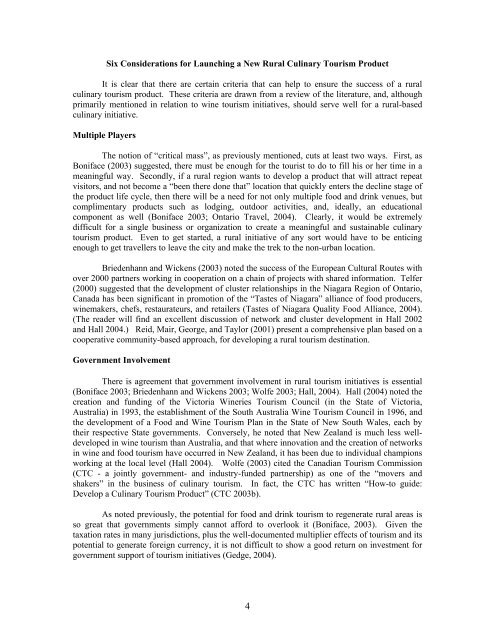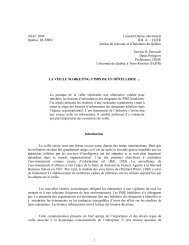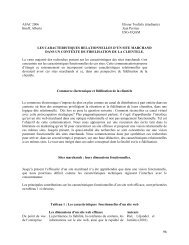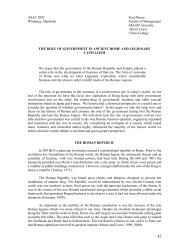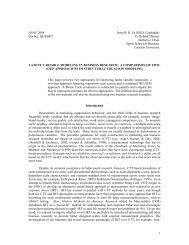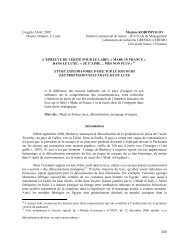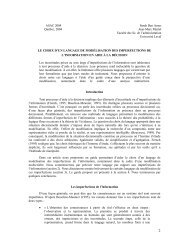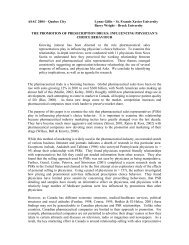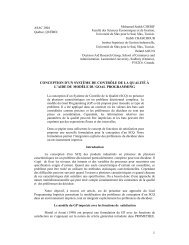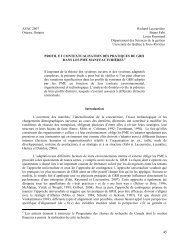ASAC 2004 Iain Murray Quebec (Quebec) School of Hospitality and ...
ASAC 2004 Iain Murray Quebec (Quebec) School of Hospitality and ...
ASAC 2004 Iain Murray Quebec (Quebec) School of Hospitality and ...
You also want an ePaper? Increase the reach of your titles
YUMPU automatically turns print PDFs into web optimized ePapers that Google loves.
Six Considerations for Launching a New Rural Culinary Tourism Product<br />
It is clear that there are certain criteria that can help to ensure the success <strong>of</strong> a rural<br />
culinary tourism product. These criteria are drawn from a review <strong>of</strong> the literature, <strong>and</strong>, although<br />
primarily mentioned in relation to wine tourism initiatives, should serve well for a rural-based<br />
culinary initiative.<br />
Multiple Players<br />
The notion <strong>of</strong> “critical mass”, as previously mentioned, cuts at least two ways. First, as<br />
Boniface (2003) suggested, there must be enough for the tourist to do to fill his or her time in a<br />
meaningful way. Secondly, if a rural region wants to develop a product that will attract repeat<br />
visitors, <strong>and</strong> not become a “been there done that” location that quickly enters the decline stage <strong>of</strong><br />
the product life cycle, then there will be a need for not only multiple food <strong>and</strong> drink venues, but<br />
complimentary products such as lodging, outdoor activities, <strong>and</strong>, ideally, an educational<br />
component as well (Boniface 2003; Ontario Travel, <strong>2004</strong>). Clearly, it would be extremely<br />
difficult for a single business or organization to create a meaningful <strong>and</strong> sustainable culinary<br />
tourism product. Even to get started, a rural initiative <strong>of</strong> any sort would have to be enticing<br />
enough to get travellers to leave the city <strong>and</strong> make the trek to the non-urban location.<br />
Briedenhann <strong>and</strong> Wickens (2003) noted the success <strong>of</strong> the European Cultural Routes with<br />
over 2000 partners working in cooperation on a chain <strong>of</strong> projects with shared information. Telfer<br />
(2000) suggested that the development <strong>of</strong> cluster relationships in the Niagara Region <strong>of</strong> Ontario,<br />
Canada has been significant in promotion <strong>of</strong> the “Tastes <strong>of</strong> Niagara” alliance <strong>of</strong> food producers,<br />
winemakers, chefs, restaurateurs, <strong>and</strong> retailers (Tastes <strong>of</strong> Niagara Quality Food Alliance, <strong>2004</strong>).<br />
(The reader will find an excellent discussion <strong>of</strong> network <strong>and</strong> cluster development in Hall 2002<br />
<strong>and</strong> Hall <strong>2004</strong>.) Reid, Mair, George, <strong>and</strong> Taylor (2001) present a comprehensive plan based on a<br />
cooperative community-based approach, for developing a rural tourism destination.<br />
Government Involvement<br />
There is agreement that government involvement in rural tourism initiatives is essential<br />
(Boniface 2003; Briedenhann <strong>and</strong> Wickens 2003; Wolfe 2003; Hall, <strong>2004</strong>). Hall (<strong>2004</strong>) noted the<br />
creation <strong>and</strong> funding <strong>of</strong> the Victoria Wineries Tourism Council (in the State <strong>of</strong> Victoria,<br />
Australia) in 1993, the establishment <strong>of</strong> the South Australia Wine Tourism Council in 1996, <strong>and</strong><br />
the development <strong>of</strong> a Food <strong>and</strong> Wine Tourism Plan in the State <strong>of</strong> New South Wales, each by<br />
their respective State governments. Conversely, he noted that New Zeal<strong>and</strong> is much less welldeveloped<br />
in wine tourism than Australia, <strong>and</strong> that where innovation <strong>and</strong> the creation <strong>of</strong> networks<br />
in wine <strong>and</strong> food tourism have occurred in New Zeal<strong>and</strong>, it has been due to individual champions<br />
working at the local level (Hall <strong>2004</strong>). Wolfe (2003) cited the Canadian Tourism Commission<br />
(CTC - a jointly government- <strong>and</strong> industry-funded partnership) as one <strong>of</strong> the “movers <strong>and</strong><br />
shakers” in the business <strong>of</strong> culinary tourism. In fact, the CTC has written “How-to guide:<br />
Develop a Culinary Tourism Product” (CTC 2003b).<br />
As noted previously, the potential for food <strong>and</strong> drink tourism to regenerate rural areas is<br />
so great that governments simply cannot afford to overlook it (Boniface, 2003). Given the<br />
taxation rates in many jurisdictions, plus the well-documented multiplier effects <strong>of</strong> tourism <strong>and</strong> its<br />
potential to generate foreign currency, it is not difficult to show a good return on investment for<br />
government support <strong>of</strong> tourism initiatives (Gedge, <strong>2004</strong>).<br />
4


